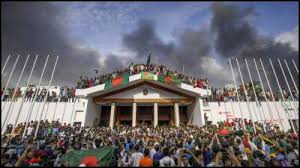India, deeply concerned about the situation in Bangladesh, will have to adopt a holistic and strategic approach, pieced together with cooperation, mutual support, and long-term planning, to help the neighbouring country emerge from the current crisis by Anil Singh

The dramatic ousting of Prime Minister Sheikh Hasina has thrown the country into deep political instability. The event brought both hope and trepidation, more so for the significant garment industry in Bangladesh. What started as mass protests against politicized admission quotas for government jobs snowballed into full-scale violence, with at least 174 killed and more than 2,500 arrested. The government imposed a curfew, deployed soldiers, and shut down internet access nationwide to control the situation. Despite these measures, protests continue, with demonstrators demanding the resignation of Prime Minister Sheikh Hasina.
These protests have come at a high cost in terms of lives; it is said that more than 200 people have lost their lives, and several thousands have been injured. The government’s stance has been widely condemned, with Nobel Peace Prize winner Muhammad Yunus calling for international intervention to put a stop to the violence. The worst incidents amidst all this chaos include attacks on religious centers, like the burning down of an ISKCON temple in Meherpur. Equally, the state of Bangladesh is now equated to some of the global mass protests leading to the overthrow of major governments, such as Sri Lanka in 2022 and Egypt in 2011.
Twists and Turns
The streets of Dhaka are saturated with military presence, with sandbagged bunkers set up at junctions and key roads already blocked by barbed wire. Defying the curfew, people have taken to the streets once again, driven by necessity. The countrywide blackout of internet services has severely banned the flow of information, which has impeded day-to-day life and communication. The international community has expressed its concern regarding the situation in Bangladesh. Many global leaders and organizations have called for intervention and support to put an end to the violence. Economic uncertainty looms over Bangladesh, the second-biggest garment exporter in the world, due to this political instability. Because of the turmoil, question mark hangs over the fate of the apparel production industry in the country.
The mayhem has brought together different factions of the opposition, including the Bangladesh Nationalist Party and some smaller groups. They have been very vocal against the Awami League-led government and took to the streets in several rallies and demonstrations. Those protesting include many young people at heart—students and young professionals alike. This shows that there is something of a generational change and a great demand for better, cleaner governance. The government has faced allegations of suppressing media reports on protests. The authorities have detained a number of journalists, while some news houses have been banned. Amidst the internet blackouts, some information is still finding its way to social media sites as protesters use VPNs and other means to bypass restrictions.
Unfortunately, the level of violence and agitation has now forced hundreds of families, especially those from the urban areas of Dhaka, to move. Relief is on its way, although, for many, life remains rather pathetic as of now. Hospitals and clinics are swamped with injured protestors and civilians, while some reports indicate a shortage of medical supplies and personnel. This turmoil is likely to have long-term implications for the political landscape of Bangladesh. It may cause the systems of leadership and management to change dramatically. However, the economic recovery will be long and painful, especially for industries like the garment manufacturing sector, which are highly troubled by this instability. Innumerable international organizations have pledged humanitarian aid to the millions of people who have been adversely affected by this turmoil. This aid includes medication, food, and shelter. Efforts are now being made in the realm of diplomacy to negotiate the situation and bring about a peaceful settlement. Neighboring countries and other global powers are observing developments with a hawk’s eye.
Other potential ways out of the current crisis include a compromise by the government with opposition groups, further escalation, or even international intervention. Again, public sentiment is a very critical factor. In a time of widespread dissatisfaction with the current government, any resolution must address the root issues of corruption, governance and economic inequality.”
Impact on India
The political unrest in Bangladesh brings along with it definite threats to the healthy trade relations with India. Both have been major trading partners with a wide exchange of goods and services. Any disruption in the trade routes and supply chain may hit industries such as textiles, pharmaceuticals, and even agriculture. Indian businesses investing in Bangladesh are bound to be full of uncertainties. Instability might, in turn, discourage future investment and influence projects under implementation, especially in sectors such as infrastructure and energy. The other important and sensitive issue for India is the 4,096-km-long border shared with Bangladesh. As the turmoil fosters, the cross-border movement could intensify, opening up scope for refugee influxes. Border security and managing the subsequent humanitarian issue will pose great challenges for India. The instability in Bangladesh also raises concerns over the resurgence of extremist groups. India had been working very closely with the Sheikh Hasina-led government on counter-terrorism activities that emanated from Bangladesh. All these efforts could get derailed with the change of guard, and therefore calls for greater vigil.
Sheikh Hasina has been a dependable friend to India in building strong bilateral ties. Her ouster has created a vacuum in the diplomatic scene, and India will have to tread cautiously in its relations with the new interim regime in Bangladesh. The crisis within Bangladesh is part of the larger looming regional instability over South Asia, amid the ongoing conflicts in Myanmar, Pakistan, and Sri Lanka. The country will have to strike a delicate balance in its diplomatic effort on many fronts to keep the regional stability intact.
With increasing violence against minorities in Bangladesh, mass exodus cannot be ruled out. It would then become incumbent upon India to be prepared to handle such an influx through humanitarian assistance and managing its social and economic fall-out. The situation can resonate with the Bangladeshi diaspora living in India, especially West Bengal and Assam. Attention will have to be paid to the safe existence and well-being of these communities.
The way forward
The turmoil in Bangladesh has consequences for stability in the region, most particularly for South Asia. Neighboring countries such as India and Myanmar are watching this situation. It is in the best interest of Bangladesh that the continuous instability may not affect its international partnerships in terms of trade agreements and diplomatic relations. The country will need to tread these challenges very carefully if it wants to retain its global standing. The steps in this direction may include negotiation between the government and opposition groups that can lead to fresh elections with changing leadership. If it is not resolved, the unrest could continue and spiral further down into bits of violence and instability. This can deal a heavy blow to the economy and social fabric of the country. In the worst-case scenario, the international community may have to step in with military intervention to quell the situation and ensure a peaceful resolution. These could be through diplomatic means, economic sanctions, or even peacekeeping forces.
The change in leadership in Bangladesh may alter the geopolitical dynamics of the region. India will need to take stock of its strategic interests and alliances in the wake of increasing Chinese influence in South Asia. In other words, India shall undertake some efforts at the diplomatic level that will sustain its moral support for a peaceful resolution to come through in Bangladesh. To this end, it could collaborate with international organizations or other regional powers toward stabilizing the situation. The situation in Bangladesh is of immense concern to India, impinging on almost all aspects of bilateral relations, regional stability, and economic development. While tackling such problems, a holistic and strategic approach has to be pieced together with cooperation, mutual support, and long-term planning. In offering a hand through cultural connections, sustainable development, and diplomatic initiatives, India shall play an important role in supporting Bangladesh at this juncture of its life and working towards a stable and prosperous future for the region.













